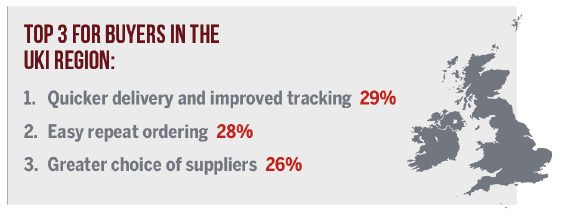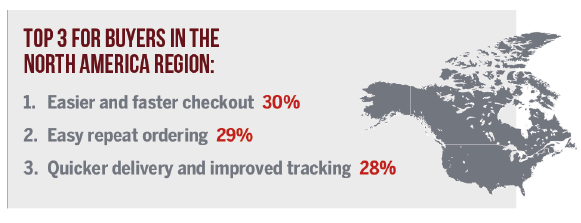As a wholesaler, distributor or manufacturer, you want customers to order from you. Not only that, but you also want them to continue ordering from you. How can you ensure that buyers choose your company during the B2B buying process? Is this even something you can influence?
Fortunately, you can. Using statistics and insights from Sana's B2B Buying Process 2019 Report, this blog will explain how. Sana commissioned an independent research agency Sapio Research for this report. They asked them to investigate the expectations B2B buyers have across each phase of the B2B buying process and the study involved 560 professional buyers who purchase from wholesalers, distributors, and suppliers.
What does the B2B buying process consist of?
The B2B buying process consists of 5 phases:
- Problem identification
- Information search
- Evaluation of alternatives
- Purchase decision
- Post-purchase decision
1. Problem identification
The study shows that the entire B2B process and cycle takes 28.2 days on average to complete. Phase 1, which is Problem identification, takes the least amount of time to complete - on average 4.5 days. Whereas phase 3, the evaluation of alternatives, takes about 6.4 days, making it the longest.
They also discovered that professional buyers never make purchasing decisions on their own. The process usually involves different company departments. So, they investigated which buyer personas are included per phase? Below is a brief overview of the results.
Several studies have shown that the number of people involved in the B2B selling process has increased in recent years. According to Forrester Research, 53% of buyers say they now take longer to decide.
2. Information search
Once the buyer has identified a problem (phase 1 of the B2B buying process), ensure that you are the one they find first when they come looking for solutions and information to solve their problem.
Today, B2B buyers prefer to first look for supporting information online. Our research shows that 62% want to access information online, whilst just 27% prefer accessing information offline. This drives the most important phase 2 tip which is ensuring that you can answer your customers’ questions online to satisfy their preferences.
Relating to phase 2 of the B2B buying process, ask yourself which channels and sources of information do buyers use when searching for information? If it’s online research, buyers mostly utilise search engines such as Google (47%).
A large percentile also uses suppliers’ websites and customer reviews (37% and 36% respectively). Forrester research shows that, on average, 47% of buyers browse 3-5 blogs or web pages before they contact a seller.
3. Evaluation of alternatives
The longest phase in the process is the process of evaluating alternatives. This typically takes an average of 6.4 days to complete according to the study. On average, about 3-5 suppliers are evaluated in the overall process, so you have to make sure you come out on top.
B2B buyers consider many factors when evaluating alternatives. However, below are the features that usually take the reins:
- Price comparisons (33%)
- Payment terms (29%)
- Inventory availability (28%)
- Delivery terms (28%)
- Product demonstration (25%)
- Product feature comparison (24%)
But which features will convince B2B customers to choose you over your competitor? It seems more than a third of the buyers surveyed in our research wanted the ability to track, place orders, manage returns and pay online. These tools trumped decision making in B2B buyers when choosing one supplier over another.
Curious about the complete list of factors? Download the B2B Buying Process Report here.
4. Purchase decision
CEOs and product teams are heavily involved in a business purchase decision. Therefore, in the purchase phase, you as a supplier will have a head start if you offer the following features:
- Good service (selected by 39% of buyers as the most important offering)
- Low price (selected by 37%)
- Favourable payment terms (selected by 31%)
- Product features (selected by 31%)
- Favourable delivery terms (selected by 30%)
- Product availability and inventory levels (selected by 29%)
- Ability to pay online (selected by 26%)
5. Post-purchase decision
Retaining your customers is important. Have they made a purchase? If so, continue to take good care of them. They are an investment. Also, make sure you satisfy their wishes and preferences.
Most B2B buyers want online access to information. Therefore, make sure your web store offers information on the following points of their interest.
The best way to offer your customers the convenience they seek is an online store that provides real-time information. This solution ensures you give customers a transparent overview of all the important information they need to know, such as inventory levels, prices, and discounts.
When speed and convenience are the number one priority for your B2B customers when it comes to placing orders online. Over a quarter of respondents in the study wish to pay in a faster, more efficient way. They also want speedy delivery and improved product tracking.
Download our B2B Buying Process Report for the complete list of B2B buyer priorities.


Looking for inspiration to make the customer search process as convenient as possible? If you’d like to learn more about preventing order mistakes, then read about top tips and tricks in the latest blog here.
Key takeaways
In conclusion, a B2B web store where customers can easily place orders is a minimum requirement for a successful e-commerce web store design. When it comes to landing customers during the B2B buying process, this is the foundation. If you truly want to stand out to your B2B customers then you need to ensure you are offering, at least, the following:
- Good basics for your online store to ensure customers can quickly and easily navigate the site to find, order and pay for products
- Features that make it easier for customers to place orders, such as fast delivery, convenient payment options, and easy order tracking
- Content that matches the pain points of your various buyer personas
Get more statistics, insights, and advice about the B2B buying process
Interested in more insights and recommendations? The B2B Buying Process 2019 Report tells you everything you need to know about B2B customers’ expectations during the buying process.
This is to include their top Key Performance Indicators (KPIs), their challenges and their expectations for their roles in the next five years.

